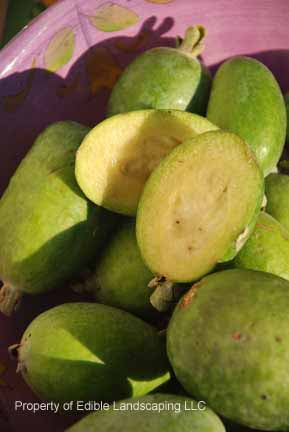
Acca sellowiana
Feijoa is an attractive evergreen shrub bearing delicious fruits with an unusual, refreshing pineapple-mint flavor. The leaves are soft green on top, silvery underneath. Withstands temperatures from about 5 degrees F to 12 degrees F. Zones 7 (sheltered) to 9.
1" wide fuchsia-like, white petal flowers have showy red centers reminiscent of fuchsia flowers. The white flower petals y are one of the best tasting edible flowers. Succulent and sweet, and vanilla like, feijoa flowers can be enjoyed alone or in fruit or vegetable salads. Low maintenance plant, no insects or diseases. Ideal for containers and can be planted at the beach because of its high salt tolerance. Feijoa looks excellent in the landscape and makes a beautiful hedge. Clients in Richmond and Virginia Beach areas find it hardy and richly rewarding to grow. Withstands temperatures from about 5 degrees F to 12 degrees F. Zones 7 (sheltered) to 9. At our nursery Feijoa planted outside on the south side of our office has overwintered and fruited since 2008,with winter injury 2014 and 15. Space 6' to 8' circle in zone 7 and 10' to 12' in zones 8 & 9. Plant two plants to insure pollination.
| Plant Characteristics | |
|---|---|
| Pest Resistance | Excellent |
| Disease Resistance | Very Good |
| Drought Tolerance | Very Good |
| Heat Tolerance | Very Good |
| Humidity Tolerance | Very Good |
| Sun Tolerance | Very Good |
| Wet Soil Tolerance | Fair |
| Shade Tolerance | Fair |
| No Spray | Excellent |
| Salt Tolerance | Very Good |
| Fresh for Kids | Good |
| Deer Resistance | Good |
| Thorns | No |
| Plant Type | Shrub |
| Soil Type | Adaptable |
| Edible Type | Fruit |
| Self Fertile | No |
|
This information is accurate to the best of our knowledge, comments/opinions are always welcome Feijoa can not be shipped to CA. Feijoa Care Guide
|
|


